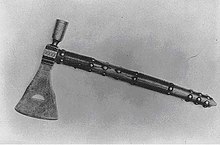Tomahawk


A tomahawk is a type of single-handed axe used by the many Indigenous peoples and nations of North America. It traditionally resembles a hatchet with a straight shaft.[1][2] In pre-colonial times the head was made of stone, bone, or antler, and European settlers later introduced heads of iron and steel. The term came into the English language in the 17th century as an adaptation of the Powhatan (Virginian Algonquian) word.
Tomahawks were general-purpose tools used by Native Americans and later the European colonials with whom they traded, and often employed as a hand-to-hand weapon. The metal tomahawk heads were originally based on a Royal Navy boarding axe (a lightweight hand axe designed to cut through boarding nets when boarding hostile ships) and used as a trade-item with Native Americans for food and other provisions.[1][2]
Etymology
The name comes from
History
The
Native Americans created a tomahawk’s poll, the side opposite the blade, which consisted of a hammer, spike or pipe. These became known as pipe tomahawks, which consisted of a bowl on the poll and a hollowed out shaft.[8] These were created by European and American artisans for trade and diplomatic gifts for the tribes.[9]
Composition

The tomahawk's original designs were fitted with heads of bladed or rounded stone or deer antler.[3][10]

According to Mike Haskew, the modern tomahawk shaft is usually less than 2 ft (61 cm) in length, traditionally made of hickory, ash, or maple.
In colonial French territory, a different tomahawk design, closer to the ancient European francisca, was in use by French settlers and local peoples.[11] In the late 18th century, the British Army issued tomahawks to their colonial regulars during the American Revolutionary War as a weapon and tool.[12]
Modern use
Tomahawks are useful in camping and bushcraft scenarios. They are mostly used as an alternative to a hatchet, as they are generally lighter and slimmer than hatchets. They often contain other tools in addition to the axe head, such as spikes or hammers.[13]

Modern, non-traditional tomahawks were used by selected units of the
Many of these modern tomahawks are made of
Tomahawk throwing competitions

Tomahawk throwing[17] is a popular sport among American and Canadian historical reenactment groups, and new martial arts such as Okichitaw have begun to revive tomahawk fighting techniques used during the colonial era.[18] Tomahawks are a category within competitive knife throwing. Today's hand-forged tomahawks are being made by master craftsmen throughout the United States.[14][19]
Today, there are many events that host tomahawk throwing competitions.[20]
The tomahawk competitions have regulations concerning the type and style of tomahawk used for throwing. There are special throwing tomahawks made for these kinds of competitions. Requirements such as a minimum handle length and a maximum blade edge (usually 4 in [100 mm]) are the most common tomahawk throwing competition rules.[20]
Military application

Tomahawks were used by individual members of the
Law enforcement
The tomahawk has gained some respect from members of various law enforcement tactical (i.e. "SWAT") teams. Some companies have seized upon this new popularity and are producing "tactical tomahawks". These SWAT-oriented tools are designed to be both useful and relatively light. Some examples of "tactical tomahawks" include models wherein the shaft is designed as a Pry Bar.
Modern tomahawk fighting
There are not many systems worldwide which teach fighting skills with the axe or a tomahawk to civilians. .
In the 20th and 21st century, tomahawks have been prominently featured in films and video games (e.g.
Manufacturers
Modern tomahawk manufacturers include:
- American Tomahawk Company
- RMJ Tactical
- Benchmade Knife Company
- SOG Specialty Knives
- Gerber Legendary Blades
- Cold Steel
- Winkler Knives
- Walk By Faith 777
See also
- Foam tomahawk
- Hurlbat
- Mambele/Hunga Munga
- Native American weaponry
- Shepherd's axe
- Tomahawk chop
References
- ^ Blade Magazine. 30 (9): 26–34.
- ^ Blade Magazine. 33 (9): 30–37.
- ^ ISBN 0-618-06509-1.
- ^ "tëmahikàn". Lenape Talking Dictionary. Retrieved October 27, 2012.
The Lenape root təmə- means 'to cut off' and the suffix -hikan forms the names of tools
- ISBN 978-1-4389-6661-8.
- ISBN 978-3-11-014335-5.
- ^ "History and Origins of the Tomahawk". Tomahawk History. 3 June 2021. Retrieved 10 June 2021.
- – via The Cupola: Scholarship at Gettysburg College.
- ^ "Tomahawk History". Hawk Throwing. Retrieved 22 July 2014.
- ISBN 0806133465. Retrieved 2012-11-17.
The wooden ballheaded club at this time was also generally referred to as a 'tomahawk'
- ^ Blade Magazine. 28 (9): 12–19.
- ^ Dick, Steven (2002-05-01). "Frontier Hatchets still On Duty". Tactical Knives. 10 (5): 43–47.
- ]
- ^ Blade Magazine: 12–19.
- ^ "Marines Stuck On Tomahawk" (PDF). The Pittsburgh Press. February 25, 1968. p. 2. Archived from the original (PDF) on August 25, 2006. Retrieved July 14, 2008.
- ^ a b c d Emerson, Ernest (2007). "The Modern Tomahawk". American Handgunner: 15.
- ^ "How to Throw a Tomahawk". Hatchets and Axes. February 23, 2011. Retrieved May 3, 2011.
- ^ Taillon, Joan (September 1, 2004). "Toronto martial arts group visits North Korea". The Aboriginal Newspaper of Ontario. Vol. 3, no. 8. p. 2. Retrieved July 20, 2008.
- ^ "Tomahawk Makes Front Page News in San Francisco" (PDF). Mountaineer-Herald. January 25, 1968. p. 8. Archived from the original (PDF) on August 22, 2006. Retrieved July 14, 2008.
- ^ a b "Tomahawk Throwing Competitions". Awesome Axes. January 1, 2022.
- ^ Tillett, David (April 15, 2003). "Lethal Weapon:Historic Tomahawk Returns to the Battlefield with Some U.S. Troops". ABC News. Retrieved January 24, 2007.
- OCLC 458890478.
- ISBN 9781621545316.
- ISBN 9781482021271.
- ISBN 978-1-58160-729-1.
